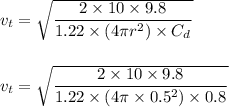
Physics, 16.07.2020 02:01 bernardhenderso4459
1. A sphere with a mass of 10 kg and radius of 0.5 m moves in free fall at sea level (where the air density is 1.22 kg/m3). If the object has a drag coefficient of 0.8, what is the object’s terminal velocity? What is the terminal velocity at an altitude of 5,000 m, where the air density is 0.736 kg/m3? Show all calculations in your answer.

Answers: 3


Another question on Physics

Physics, 21.06.2019 22:30
Curious carl calculated the density of a cube to be 4.50 g/cm3. what is the density of the cube in g/l?
Answers: 1

Physics, 22.06.2019 01:40
Lin yao looks at the back of a spoon. how should she describe her reflection? upside down and smaller upside down and larger right-side up and smaller right-side up and larger
Answers: 1

Physics, 22.06.2019 15:10
Suppose that f : rn → rm and that a ∈ k, where k is a connected subset of rn . suppose further that for each x ∈ k there exists a δx > 0 such that f(x) = f(y) for all y ∈ bδx (x). prove that f is constant on k; that is, f(x) = f(a) for all x ∈ k
Answers: 1

Physics, 22.06.2019 19:40
Uranium has two naturally occurring isotopes. 238u has a natural abundance of 99.3% and 235u has an abundance of 0.7%. it is the rarer 235u that is needed for nuclear reactors. the isotopes are separated by forming uranium hexafluoride uf6, which is a gas, then allowing it to diffuse through a series of porous membranes. 235uf6 has a slightly larger rms speed than 238uf6 and diffuses slightly faster. many repetitions of this procedure gradually separate the two isotopes. what is the ratio of the rms speed of 235uf6 to that of 238uf6? express your answer to five significant figures.
Answers: 3
You know the right answer?
1. A sphere with a mass of 10 kg and radius of 0.5 m moves in free fall at sea level (where the air...
Questions

Geography, 16.02.2021 14:00


Mathematics, 16.02.2021 14:00


Mathematics, 16.02.2021 14:00

Mathematics, 16.02.2021 14:00


Chemistry, 16.02.2021 14:00

Mathematics, 16.02.2021 14:00


Mathematics, 16.02.2021 14:00




Mathematics, 16.02.2021 14:00

Mathematics, 16.02.2021 14:00



Mathematics, 16.02.2021 14:00

 .
. .
. .
.



 = 4 x 3.142 x
= 4 x 3.142 x  = 3.142 m^2
= 3.142 m^2
 = 7.99 m/s
= 7.99 m/s = 10.298 m/s
= 10.298 m/s 

